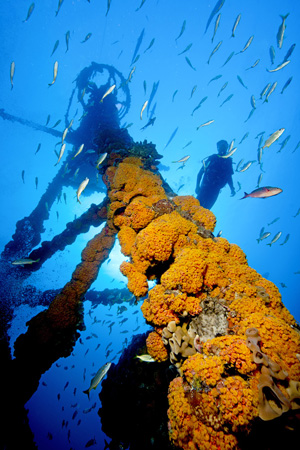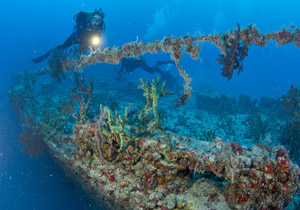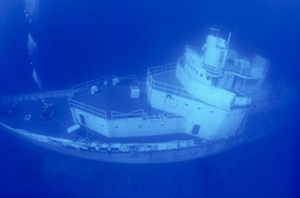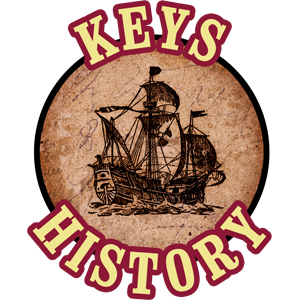Spotlight Shines on Key Largo Shipwreck Anniversaries in 2017
KEY LARGO, Florida Keys — Avid divers can commemorate two significant Key Largo shipwreck anniversaries in 2017. In June, the 510-foot U.S. Navy ship Spiegel Grove marks 15 years since its journey to the bottom, and two U.S. Coast Guard cutters mark 30 years in November. Each is an undersea playground for advanced- and wreck-certified divers.
Spiegel Grove, the third-largest vessel intentionally sunk to become an artificial reef, is positioned about 6 miles off Key Largo. Designed to carry cargo and craft for amphibious landings, Spiegel Grove was retired by the Navy in 1989 and spent 12 years tethered in the naval "Mothball Fleet" on Virginia's James River.
After an elaborate cleaning process and subsequent tow to its scuttle site, the "Spiegel" prematurely sank and rolled over May 17, 2002, leaving its upside-down bow protruding above the surface. Three weeks later, a salvage team fully sank the vessel and it came to rest on its starboard side in 130 feet of water.
The premature sinking and incorrect orientation of the vessel attracted worldwide attention to the project — so much, in fact, that Key Largo's Fish House Restaurant created a Spiegel Grove cocktail that is still served today. The concoction's recipe calls for three types of rum and a blue liqueur to provide the drink, served in an oversized martini glass, its signature color.
In July 2005, Hurricane Dennis brushed the Florida Keys and, much to the surprise of the dive community, storm surge pushed the vessel into the originally planned upright position.
Mooring buoys provide convenient boat tie-offs. The top deck is about 60 feet below the surface. The ship is so wide that, on clear days, the view of the superstructure fades into a green-blue abyss and the sandy bottom is visible at 100-plus feet.
Two other Keys shipwrecks were scuttled Nov. 27 and Nov. 28,1987, in proximity to one another. Dubbed "the 327s," the twin Treasury Class 327-foot U.S. Coast Guard cutters rest in nearly 130 feet of water 1 mile south of Molasses Reef off Key Largo.
Built in 1936, the Duane was named for Secretary of the Treasury William L. Duane who served under Andrew Jackson. In 2002, it was added to the National Registry of Historic Places.
The Bibb, named after prominent Kentucky lawyer and U.S. Senator George Motier Bibb, served in a variety of capacities between 1937 and 1985 in active patrol duty and as a convoy escort.
Considered the service's flagships, these cutters gained some notoriety for their battles with German U-boats on the North Atlantic and in the Mediterranean.
Since becoming two of the Keys' most intriguing artificial reefs, the Duane and Bibb wrecks have attracted large pelagic species and sizeable sea turtles. There's no shortage of big barracuda or the occasional manta ray or whale shark, especially during springtime migrations. Corals, gorgonians and basket sponges cloak the twins' decks.
Florida Keys diving information: fla-keys.com/diving
Florida Keys visitor information: fla-keys.com or 1-800-FLA-KEYS
Social: Facebook • Twitter • Instagram• YouTube• KeysVoices.com

The U.S. Coast Guard Cutter, Duane, named for Secretary of the Treasury William L. Duane who served under Andrew Jackson, was intentionally sunk off Key Largo Nov. 27, 1987. Images: Stephen Frink

Divers explore the top deck of Spiegel Grove, which is about 60 feet below the surface.

Since becoming two of the Keys' most intriguing artificial reefs, the Duane and Bibb wrecks have attracted large pelagic species and sizeable sea turtles.

